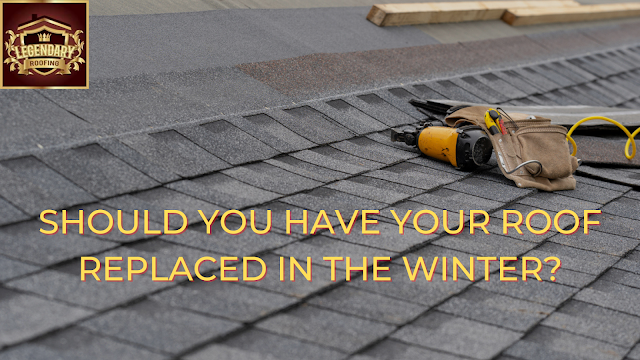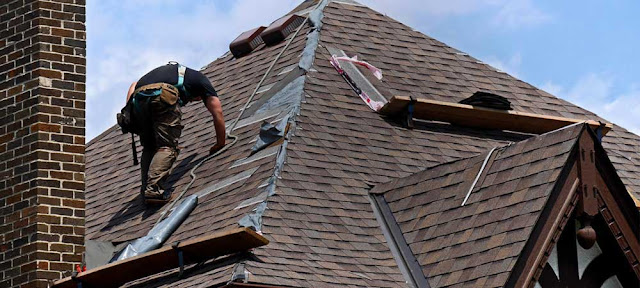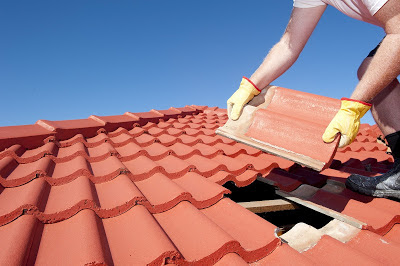Tuesday, December 29, 2020
SHOULD YOU HAVE YOUR ROOF REPLACED IN THE WINTER?
Wednesday, October 14, 2020
Why it's Important to Maintain Your Roof?
One of the ways to ensure your roof lasts as long as possible and protects your home and belongings are to have regular roof maintenance done.
If you don’t do anything about these issues, then you will have to spend thousands of dollars on repairs or to replace your roof.
By calling in a professional to do regular maintenance, you can take care of small issues before they become huge problems. This will save you money in the long run and ensure that your roof protects your home.
1. It Increases the Life of the Roof
2. Helps you to detect Problems Early
3. Roof will look Good
4. It saves Money
If you aren’t comfortable or don’t have the time to inspect and repair your roof, we’re here to help. Contact Legendary Roofing Houston and we will gladly inspect and help you maintain your roof.
or reload the browser
or reload the browser
or reload the browser
or reload the browser
or reload the browser
or reload the browser
Tuesday, September 29, 2020
Home Preparation for Hurricane (Part 2)
Your home is one of your largest investments, so protecting it from natural disasters is probably one of your top priorities.
This year, the National Oceanic and Atmospheric Administration's (NOAA) Climate Prediction Center expects a "near-normal" hurricane season. That means approximately 10 to 16 named storms, including four to eight hurricanes, one to four of which may be severe, between June 1 and Nov. 30.
Landscaping
- Trim trees, shrubbery, and dead limbs, especially ones close to your home.
- Repair or replace broken or damaged fences.
Doors
- Reinforce garage doors and tracks or replace them with a hurricane tested the door.
- Reinforce double entry doors with heavy-duty foot and head bolts.
- Use a security deadbolt with a one-inch minimum bolt length.
Windows
- If possible, install tested/manufactured hurricane shutters.
- Inspect existing shutters to ensure they are in good working order.
or reload the browser
or reload the browser
Monday, September 21, 2020
Home Preparation for Hurricane (Part 1)
Your home is one of your largest investments, so protecting it from natural disasters is probably one of your top priorities.
This year, the National Oceanic and Atmospheric Administration's (NOAA) Climate Prediction Center expects a "near-normal" hurricane season. That means approximately 10 to 16 named storms, including four to eight hurricanes, one to four of which may be severe, between June 1 and Nov. 30.
Roof
- Inspect the roof for loose tiles, shingles or debris.
- Consider replacing old or damaged shingles with new ones rated for hurricane force winds.
- Clear loose and clogged rain gutters and downspouts.
Secure and seal your roof
- Inspect your roof covering to make sure all the shingles or tiles are secured and that none are cracked or missing.
Review your insurance policies
- Your insurance policy will cover the full cost of rebuilding if you lose your home in a Hurricane.
Take an inventory of your property
- Survey your home and tally your possessions each year, so you know exactly what you need to replace and how much it's worth.
Elevation Matters
- Know the elevation of your home! Are you in a flood and/or evacuation zone?
Seal windows and doors
- Check the seals around your windows and doors. Normal weather, especially in hot climates can damage seals over time, allowing sideways-blowing rain to get in during a storm.
Hurricane Preparation
For more information on home preparedness, please visit the Legendary Roofing Houston at:
www.legendaryroofinghouston.com
Thursday, August 13, 2020
How Does a Hurricane Affect your Roof?
Houston is no stranger to Hurricanes. High winds, rising water and property damage are common place issues around the coastline. How does a hurricane affect a roof and what should you do as soon as you know that there is even a possibility of being hit?
Curling and Stripped Shingles
Most
roof damage starts with subtle changes to the material surfaces. Take a look at
your roof after a wind event, for instance. The flat shingles may now have
curled edges. Moisture can make its way under the shingles. Tiny granules
found on new shingles are part of the design, but they strip away under extreme
conditions. You might see pebbles on the ground after the storm indicating roof
damage.
Wind Damage
Wind
that moves along the ground will encounter your structure and lift up over it.
The eaves become makeshift sails, leading to roof damage. Roofs secured to
the walls with proper fasteners protect the home. Roofers will still need to
examine these issues. Any loose fasteners can lead to roof failure under strong
winds.
Hail Strikes
Hurricanes
come with rain, winds, lightning and hailstorms. Divots may dot your rooftop
after hail strikes and are more serious in nature. Be sure to have a
professional roofer examine your roof as soon as the storm passes on. Hail
divots that seem benign may have cracks in the underlayment below.
Leaks Into Attic
Hurricanes
don't just impact the top of the roof either. As shingles shift in the wind,
moisture finds its way into tiny cracks on the rooftop. You might see moisture
or yellow staining in the attic afterwards. This moisture damage can be
severe if the rains continue in the region. Repairing the damage immediately
after the storm is imperative. Water will corrode the home's interior if left
unchecked.
Penetrations Detaching From Roof
Antennas,
satellite dishes and skylights might detach from the structure. The detachment
leaves an opening for wind and rain to further damage the roof. As they fall
down, another damaged area develops. Objects that aren't attached to the
roof, such as trees, can also be hazards. Weak tree branches falling onto the
home will cause significant damages.
Preparing for a Storm
You should have professionals evaluate your roof and repair
any minor damage as soon as possible. We can suggest materials to meet your weather
needs and budget. Keeping up with roofing repair issues will protect your home
as much as possible during a storm.
For a free estimate give Legendary Roofing Houston a call at (346) 763-5534.
Connect with Us
Monday, July 20, 2020
How to Prepare for Hurricane Season
Our professionals at Legendary Roofing offer these tips to reduce damages that could be caused by a Hurricane.
Check Your Attic
Before Hurricane season comes around, it is a good idea to take a walk-through of your attic to inspect the ventilation and look for any loose or compromised areas such as your eaves, soffits, and gable vents. In addition, you can take this opportunity to look for signs of previous water intrusion, like stains, damp wood, peeling paint, moist insulation, or even mould. Any issues in your attic need to be taken care of promptly to ensure that the heavy rains that come with a hurricane don't find their way into your attic and cause additional damage.
Inspect and Clean Your Gutters
Clogged gutters can cause your gutter system to back up in the event of heavy rains, leaving the water to pool on your roof where it can then intrude into other areas of your home. Before this hurricane season hits, it is a good idea to make sure your gutters are clear of any blockages and debris that could cause them to back up during heavy rainfall.
Look For Loose Tiles and Shingles
Any loose tiles or shingles on your roof need to be secured before a storm hits. If any of these gets ripped up during the course of the storm, your home could become vulnerable to a great deal of water damage as the rains will have a sudden entry point into your home. Make sure that your tiles or shingles are secured with caulk, screws, or nails to keep your home protected from any invading water.
Be On The Lookout For Rust, Wear, and Tear
Before a storm comes through the area, you need to be on the lookout for any rust spots, loose anchoring, cracked or worn pipe boots, exposed nails, shingle granules, detached metal connection, or any other general signs that your roof is wearing out. A roof that is already compromised doesn't stand much of a chance in the event of a major storm or even moderate storm, so if you find that you need your roof replaced, it is better to have it done before the storm season hits.
Clean and Secure Your Yard
Taking the time to clean up your yard and secure any loose items before a storm means that there is less chance of random debris flying about and becoming projectiles that could put your roof at risk. You should move any of these items indoors and, if not, make sure they are secured somewhere safe.
Trim Your Trees
Before a storm arrives, it is a good idea to make sure your trees are trimmed back and any dead branches or limbs are removed. During the high winds during a hurricane, these can easily be blown off and fall on your roof, causing severe damage depending on their size.
After the Storm
When
Storms are over, check your home and property for damage. If you see any signs
of damage, call your insurance company right away, and make sure to take
pictures.
If
there’s damage to the roof, don’t forget to contact Legendary RoofingHouston. We’ll inspect your roof for free and work with your insurance company
to get you the best deal on repairs or a new roof.
Connect with Us
Thursday, June 4, 2020
Roof Flashing – Surefire Solution to Leaky Chimney
What Is Flashing On A Roof?
A leaky chimney can cause all sorts of problems that require costly repair. When we go on service calls related to leaks in the chimney system, we often find that the source of the trouble is faulty flashing.
The flashing is sheet metal installed for the purpose of ensuring that the connection between the chimney and roof is watertight, but the effectiveness of flashing eventually expires.
The best way to avoid moisture issues caused by flashing is to get an annual chimney inspection; every aspect of the chimney system is carefully inspected.
How is Flashing Installed?
Alerting Signals that Flashing Needs Repair or Replacement?
Thursday, May 21, 2020
Legendary Roofing Roof Inspections | Get a FREE Estimation
Roof Inspections in Legendary Roofing
Get a FREE Inspection & Estimation
“The only way, then, to learn about the current state of your roof is to have a roof inspection conducted.”
Connect with Us
Thursday, April 23, 2020
How Do Storms & Weather Affect Your Roof?
1. Wind Damage
2. Rain Damage
3. Tree Damage
4. Heat Damage
5. Hailstorm Damage
6. Snow Damage
Connect with Us
Tuesday, March 24, 2020
How To Prevent Roof Damage With 6 Maintenance Tips
What is Roof System, & Why does it matter?
As we know, the Roof system is arguably the most vulnerable part of a building's exterior. Ultraviolet radiation, wind, rain, hail, snow, tornado, and sleet all affect a roof system's performance.Performance is based on good design, quality materials, proper installation, and a preventive-maintenance program. Roof maintenance is critical to preventing roof problems and keeping the roof in a watertight condition. Early identification and repair of roof problems will help provide a long-lasting roof system.
What Safety Measures Should We Take?
1. Regularly inspect your roof.
Each year, before Rain/Storm season, it’s important to thoroughly examine your roof. If you aren’t comfortable with getting onto your roof, call a professional who has the experience and equipment to inspect your roof meticulously and safely. If you choose to do it yourself, check for sagging, damaged or missing shingles, algae growth, insect/animal activity and leaking light or liquid in your attic. All of these are red flags for immediate repair by you or a professional.2. Fix ponding as soon as possible
Ponding happens when the roof is able to hold standing water. Typically, the roof should be able to shed water away immediately. Standing water is quite damaging to the material and might lead to leaks. Ponding is of particular concern to the roof that is pitched rather low, but it might also happen to a steeply pitched roof in some cases.3. Clean your gutters
Gutters carry off rainwater from the roof and direct it either into a separate rainwater tank or into the sewer. In either case, if a gutter is clogged, it can cause water to pool and eat away at the material. The most common reasons that a gutter might get clogged are because of debris, usually fallen leaves or bird's nest. Since gutters are curved inward to prevent water from spilling over, it can be difficult to determine if debris is clogging it. Only when rot is visible or when water pours over the gutter would it be evident that it is clogged.4. Trim your trees.
Some limbs can get too close for comfort. If part of a tree is almost touching or resting on your roof, that’s cause for major concern. During storms, limbs can swing several feet or fall due to high winds. If you don’t end up with a hole in your roof, you’ll probably lose a few shingles. Trimming your trees also discourages animals from getting into chimneys, walls, vents, etc.5. Check flashings integrity regularly
Flashings are flexible metals placed around joints or openings to prevent water from seeping through. Flashings are a common site for leaks as they are sometimes manipulated in different shapes to cover the joint or opening, occasionally punctured to be fixed in place.These places are around vents, chimneys, valleys, pipes, and skylights. Signs that flashings are damaged usually involve rusting or bending on the material.6. Inspect and repair seals, joints, and flashing
Seals, joints, and flashing are the most common places for leaks. Dried or loose sealant and punctures are signs of vulnerability. Don’t ignore them.Extending the life of your roof comes down to taking immediate action once you identify a problem. Keep an eye on your gutters, trees, snow, and debris and you’ll have prevented a slew of issues.
It is important that you or a professional inspect your roof at least annually (preferably twice, in both the fall and spring) to ensure that any damage unapparent from the ground or the untrained eye is tended to immediately.
If you don’t feel qualified or safe performing a thorough inspection, give us a call!
















